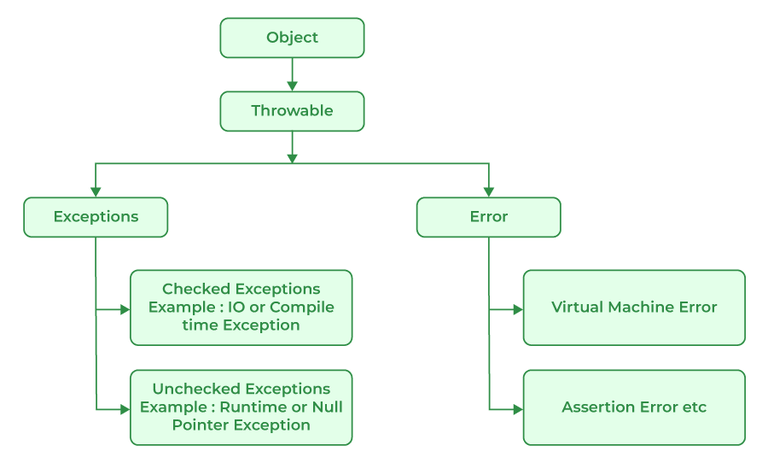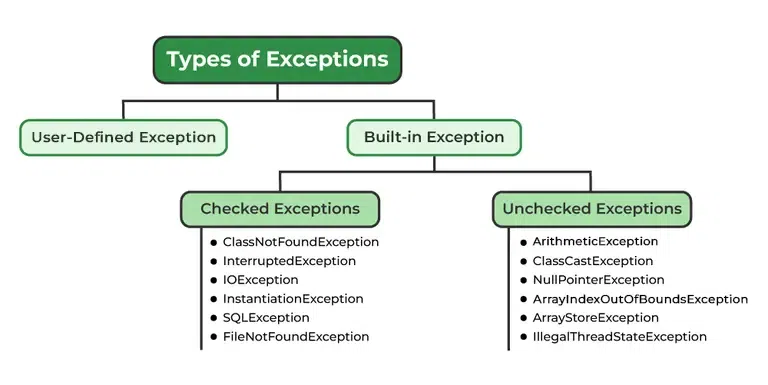Exception Handling
An exception is an event that occurs during the execution of a program that disrupts the normal flow of instructions. When an exception occurs, the program terminates abruptly, and the control is transferred to the exception handler.

In Java, exceptions are objects that represent an abnormal condition or error. Exceptions can occur due to various reasons, such as invalid input, file not found, network issues, arithmetic errors, etc.
Types of Exceptions
Java exceptions are divided into two categories: checked exceptions and unchecked exceptions.
In Java, exceptions are organized in a hierarchy of classes. The Throwable class is the superclass of all exceptions and errors in Java. The Exception class is a subclass of Throwable and is the superclass of all checked exceptions. The RuntimeException class is a subclass of Exception and is the superclass of all unchecked exceptions.

Checked Exceptions
Checked exceptions are exceptions that are checked at compile time. These exceptions are subclasses of the Exception class but not subclasses of the RuntimeException class. Checked exceptions must be caught or declared in the method signature using the throws keyword.
Examples of checked exceptions include IOException, SQLException, ClassNotFoundException, etc.
Unchecked Exceptions
Unchecked exceptions are exceptions that are not checked at compile time. These exceptions are subclasses of the RuntimeException class. Unchecked exceptions do not need to be caught or declared in the method signature.
Examples of unchecked exceptions include ArithmeticException, NullPointerException, ArrayIndexOutOfBoundsException, etc.
Exception Handling in Java
Java provides a robust exception handling mechanism to deal with exceptions. The try, catch, and finally blocks are used to handle exceptions in Java.
try Block
The try block is used to enclose the code that might throw an exception. It is followed by one or more catch blocks and an optional finally block.
catch Block
The catch block is used to handle the exception that is thrown in the try block. It contains the code that handles the exception. A try block can have multiple catch blocks to handle different types of exceptions.
finally Block
The finally block is used to execute the code that should be run regardless of whether an exception is thrown or not. It is executed after the try block and any associated catch blocks.
Example of Exception Handling
Here is an example of exception handling in Java:
public class ExceptionHandlingExample {
public static void main(String[] args) {
try {
int result = divide(10, 0);
System.out.println("Result: " + result);
} catch (ArithmeticException e) {
System.out.println("Error: " + e.getMessage());
} finally {
System.out.println("Finally block executed.");
}
}
public static int divide(int a, int b) {
return a / b;
}
}In this example, the divide method throws an ArithmeticException when dividing by zero. The exception is caught in the catch block, and the finally block is executed regardless of whether an exception occurs or not.
Custom Exceptions
In addition to the built-in exceptions provided by Java, you can create your own custom exceptions by extending the Exception class or one of its subclasses. Custom exceptions are useful for handling application-specific errors or conditions.
Here is an example of a custom exception:
public class CustomExceptionExample {
public static void main(String[] args) {
try {
throw new CustomException("Custom exception message");
} catch (CustomException e) {
System.out.println("Error: " + e.getMessage());
}
}
}
class CustomException extends Exception {
public CustomException(String message) {
super(message);
}
}In this example, we define a custom exception CustomException that extends the Exception class. We then throw this custom exception and catch it in the main method.